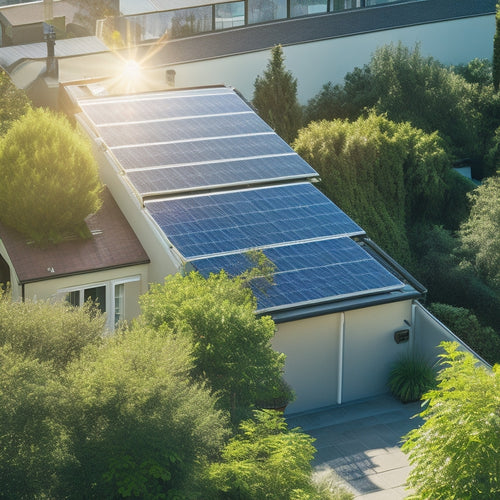
Leading Solar Panel Technologies for a Sustainable Future
Share
You're already embracing a sustainable future by leveraging state-of-the-art solar panel technologies that can increase energy output by up to 25%, reduce production costs, and enhance durability. Bifacial panels, for instance, capture energy from both sides, while perovskite cells boast high power conversion efficiencies. Monocrystalline silicon panels excel in performance and longevity, and thin-film technology offers reduced material usage and flexibility. Concentrated photovoltaic systems and innovative materials like organic photovoltaics and solar nanotechnology further expand the possibilities. As you investigate these leading solar panel technologies, you'll find even more innovative solutions waiting to be revealed.
Key Takeaways
- Bifacial solar panels capture energy from both sides, enhancing efficiency by up to 25% and suitable for various installations.
- Perovskite solar cells achieve high power conversion efficiencies over 23%, with advancements in manufacturing and stability.
- High-efficiency monocrystalline silicon panels offer exceptional performance, durability, and reliability with efficiency rates up to 22%.
- Thin-film solar cells provide reduced material usage, lower production costs, and a lower carbon footprint, ideal for diverse applications.
- Concentrated photovoltaic systems use mirrors or lenses to focus sunlight, achieving higher energy yields and advanced solar tracking systems.
Bifacial Solar Panel Innovation
As you investigate the realm of solar panel technologies, one innovation that stands out is bifacial solar panel design, which has taken a quantum leap forward in recent years. This design allows solar panels to capture energy from both the front and back sides, markedly enhancing bifacial efficiency.
Bifacial applications are diverse, ranging from rooftop installations to large-scale solar farms, and even agrivoltaics, where panels are integrated into agricultural environments.
The bifacial manufacturing process has become increasingly streamlined, driving down costs and making these panels more competitive in the market. In fact, bifacial market trends suggest that demand for these panels will continue to rise, driven by their improved performance and durability.
When it comes to bifacial installation, careful planning is essential to maximize energy yield. By optimizing bifacial design and installation, you can unleash the full potential of these innovative panels.
With bifacial solar panels, you can expect higher energy output, reduced costs, and a lower carbon footprint – making them an attractive choice for those seeking reliable, sustainable power solutions.
Perovskite Solar Cells Advancements
As you investigate perovskite solar cells, you'll find significant advancements in high power conversion, which have led to improved energy harvesting capabilities.
Thin film fabrication techniques have also been refined, allowing for more efficient and cost-effective production.
Moreover, researchers have made notable stability enhancements, addressing concerns about the long-term reliability of perovskite solar cells.
High Power Conversion
While researchers have been pushing the boundaries of silicon-based solar cells for decades, perovskite solar cells have emerged as a promising alternative, boasting high power conversion efficiency.
You're likely wondering what makes them so special. It's their ability to capture energy from the sun more effectively, leading to higher power output.
Some key benefits of high power conversion in perovskite solar cells include:
-
Efficiency optimization: Perovskite solar cells have shown higher power conversion efficiency rates compared to traditional silicon-based cells.
-
Solar tracking: By using perovskite solar cells, you can optimize energy output through advanced solar tracking systems, allowing for maximum energy absorption.
-
Increased energy density: High power conversion enables more energy to be generated per unit area, making perovskite solar cells ideal for large-scale energy production.
-
Reduced material usage: With high power conversion, you can achieve the same energy output using fewer materials, reducing production costs and environmental impact.
-
Enhanced durability: Perovskite solar cells have shown improved durability and resistance to environmental stressors, ensuring a longer lifespan and reduced maintenance costs.
Thin Film Fabrication
Researchers have made considerable progress in perovskite solar cell fabrication, particularly in thin film technology. You'll find that advancements in thin film fabrication have led to improved solar cell materials, resulting in increased energy conversion efficiency. This is achieved through advanced fabrication techniques, which minimize environmental impact while reducing production costs.
| Fabrication Technique | Advantages |
|---|---|
| Chemical Vapor Deposition | High uniformity, scalable |
| Spin Coating | Low cost, simple process |
| Sputtering | High deposition rate, good adhesion |
| Molecular Beam Epitaxy | High precision, low defect density |
As the market trends towards more cost-efficient and environmentally friendly solar panels, perovskite solar cells are becoming increasingly popular. However, manufacturing processes and recycling methods still pose scalability challenges. Despite these challenges, researchers continue to push efficiency benchmarks, with some perovskite solar cells achieving power conversion efficiencies over 23%. As you consider the future of solar panel technology, it is crucial to stay informed about the latest advancements in thin film fabrication and their implications for a sustainable energy future.
Stability Enhancements
The Achilles' heel of perovskite solar cells - stability - has long hindered their widespread adoption. You may have impressive efficiencies, but if your cells can't withstand the test of time, they're not viable for commercial use.
Fortunately, researchers have made notable progress in stability enhancements, clearing the path for perovskite solar cells to become a more reliable option.
To achieve this, you'll need to conduct rigorous stability testing and durability assessment. This involves subjecting cells to various environmental stressors, such as heat, humidity, and light, to see how they hold up.
Here are some key advancements in stability enhancements:
- Interface engineering: Modifying the interface between the perovskite layer and other layers to reduce degradation
- Composition optimization: Tweaking the perovskite composition to improve its inherent stability
- Encapsulation techniques: Developing better encapsulation methods to protect the cells from environmental stressors
- Stability-oriented fabrication: Designing fabrication processes that prioritize stability over efficiency
- Accelerated lifetime testing: Developing new methods to accelerate aging processes and predict long-term stability
High-Efficiency Monocrystalline Silicon
Across the solar panel terrain, high-efficiency monocrystalline silicon stands out for its exceptional performance and reliability.
You'll notice that monocrystalline silicon boasts higher efficiency rates compared to other materials, with some panels reaching up to 22% efficiency. This means you can generate more power per unit area, making it an attractive option for those seeking maximum energy output.
The high purity of monocrystalline silicon also contributes to its exceptional performance. With fewer impurities, the material can convert sunlight into electricity more effectively, resulting in higher energy yields.
Additionally, monocrystalline silicon solar cells have a longer lifespan, with an average lifespan of 30 years or more. This extended solar cell longevity guarantees that your investment will continue to pay off for decades to come.
When it comes to high-efficiency monocrystalline silicon, you can expect top-tier performance, durability, and reliability.
As you investigate the world of solar panels, you'll find that this technology is well-suited for those who demand maximum power and efficiency from their solar array.
Thin-Film Solar Panel Technology
Your solar panel exploration now leads you to thin-film solar panel technology, a departure from traditional silicon-based designs. This innovative approach offers a unique set of benefits that make it an attractive option for various applications.
Some key advantages of thin-film solar panel technology include:
-
Flexible applications: Thin-film panels can be integrated into building-integrated photovoltaics (BIPV) and building-applied photovoltaics (BAPV), enabling seamless installation on rooftops and facades.
-
Cost efficiency: Thin-film technology reduces material costs, making it a more affordable option compared to traditional silicon-based panels.
-
Environmental impact: Thin-film panels have a lower carbon footprint due to the reduced material usage and energy required for production.
-
Material innovations: Researchers are investigating new materials and deposition techniques to enhance thin-film panel efficiency and durability.
-
Installation challenges: Thin-film panels require specialized installation techniques and equipment, which can be a challenge for installers without experience.
As you probe deeper into thin-film technology, you'll uncover its potential to reshape the solar industry with improved performance metrics, enhanced grid integration, and effective recycling methods, ultimately driving consumer adoption and shaping market trends.
Concentrated Photovoltaic Systems
Beyond traditional solar panels, you're now entering the domain of concentrated photovoltaic systems, where innovative optical designs enhance sunlight to elevate energy output.
These systems use mirrors or lenses to focus sunlight onto a smaller area of high-efficiency photovoltaic cells, amplifying their power output. By concentrating sunlight, you can achieve higher energy yields than traditional solar panels, making them ideal for large-scale power generation.
To maximize energy output, concentrated photovoltaic systems employ advanced solar tracking systems. These systems track the sun's movement, adjusting the mirrors or lenses to guarantee maximum sunlight concentration throughout the day.
Thermal management is also vital, as the concentrated sunlight can cause temperatures to soar. Effective heat management systems, such as heat sinks or cooling systems, are used to maintain ideal operating temperatures and prevent overheating.
Solar Energy Storage Solutions
As concentrated photovoltaic systems maximize energy output, you're now faced with the next challenge: storing that energy for later use. This is where solar energy storage solutions come into play.
With the ability to store excess energy generated during the day for use during the night or on cloudy days, you can guarantee a reliable and consistent power supply.
To achieve this, various battery technologies are being developed and implemented. These include:
- Lithium-ion batteries, known for their high energy density and long lifespan
- Lead-acid batteries, a cost-effective option with a well-established manufacturing infrastructure
- Flow batteries, which store energy in a liquid electrolyte solution in external tanks
- Sodium-ion batteries, a potentially more cost-effective and sustainable alternative to lithium-ion
- Solid-state batteries, which replace the liquid electrolyte with a solid material for enhanced safety and energy density
Effective energy management is vital to optimizing solar energy storage.
Building-Integrated Photovoltaics
You're about to investigate the domain of Building-Integrated Photovoltaics (BIPV), where solar panels are seamlessly integrated into a building's design.
Thin-film solar cells enable energy generation while maintaining a building's aesthetic appeal.
You'll uncover how energy-harvesting facades and seamless roof integration can transform the manner in which buildings generate power.
Thin-Film Solar Cells
Thin-film solar cells, a type of building-integrated photovoltaic (BIPV) technology, have revolutionized the way designers and builders design energy-efficient structures.
You're likely familiar with traditional solar panels, but thin-film solar cells take it to the next level by integrating seamlessly into building facades. They're lightweight, flexible, and can be customized to fit your unique design needs.
Thin-film solar cells offer several advantages, including:
-
Lower material costs: Manufacturing processes are more efficient, reducing production costs.
-
Increased energy yield: Thin-film cells can be designed to capture more energy from indirect sunlight.
-
Improved aesthetics: They can be integrated into building facades, providing a sleek, modern look.
-
Enhanced durability: Thin-film cells are more resistant to weathering and environmental stressors.
-
Government incentives: Many governments offer rebates and tax credits for BIPV installations, helping to offset market challenges.
Energy-Harvesting Facades
Taking your building's energy efficiency to new heights, Energy-Collecting Facades, also known as Building-Integrated Photovoltaics (BIPV), integrate solar panels directly into your building's envelope.
This innovative technology alters your building's exterior into a power-generating asset, seamlessly combining energy efficiency with aesthetic design. By incorporating photovoltaic materials into your building's façade, you'll not only reduce your reliance on non-renewable sources but also minimize your environmental impact.
Urban integration is a key benefit of Energy-Collecting Facades, as they can be designed to blend in with existing design. This smart technology enables you to generate electricity while maintaining your building's original character.
Furthermore, BIPV systems offer architectural innovation, allowing for unique and customizable designs that set your building apart. By utilizing renewable sources, you'll achieve energy independence and contribute to sustainable architecture.
With Energy-Collecting Facades, you can power your building while promoting a greener future.
Seamless Roof Integration
Your building's roof is more than just a protective layer; it can be a powerhouse of energy generation with Seamless Roof Integration, also known as Building-Integrated Photovoltaics (BIPV). This innovative technology allows you to utilize the sun's energy while maintaining your building's design aesthetics.
With BIPV, solar panels are integrated into the roof's structure, providing a seamless look that's both functional and visually appealing.
Some key benefits of Seamless Roof Integration include:
-
Improved energy efficiency: BIPV systems can generate more power per unit area compared to traditional solar panels.
-
Enhanced design flexibility: Designers and builders can create roofs that not only generate energy but also meet specific building codes and regulations.
-
Reduced material costs: By integrating solar panels into the roof's structure, you can eliminate the need for separate roofing materials.
-
Streamlined installation techniques: BIPV systems can be installed simultaneously with the roofing material, reducing labor costs and time.
-
Increased property value: Buildings with BIPV systems can increase property value and appeal to environmentally conscious buyers.
Advanced Inverter Technologies
Advanced inverter technologies have revolutionized the way solar panels convert DC power into AC power, making them more efficient and reliable. You're now able to utilize the full potential of your solar panels, thanks to state-of-the-art inverters that optimize energy production.
With advanced inverter technologies, you can expect higher inverter efficiency, resulting in more power output and reduced energy losses.
These innovations also enable seamless smart grid integration, allowing you to feed excess energy back into the grid and offset your energy costs. This means you can efficiently manage your energy distribution and consumption, making the most of your solar panel investment.
Furthermore, advanced inverters provide real-time monitoring and control, enabling you to track your energy production and identify areas for improvement. By employing these technologies, you can maximize your energy yield, reduce your carbon footprint, and contribute to a sustainable future.
Next-Gen Solar Panel Materials
Five decades of solar panel development have led to a significant reduction in costs, but efficiency rates have plateaued. To overcome this hurdle, you're seeing a surge in research and development of next-gen solar panel materials.
These innovative materials hold the key to revealing higher efficiency rates, increased durability, and reduced production costs.
Some of the most promising next-gen solar panel materials include:
-
Organic Photovoltaics (OPVs): Using organic compounds to convert sunlight into electricity, OPVs offer a potentially cheaper and more flexible alternative to traditional silicon-based panels.
-
Solar Nanotechnology: By utilizing the power of nanoparticles, solar nanotechnology can increase energy absorption and conversion rates, leading to more efficient solar panels.
-
Perovskite Solar Cells: These cells have shown extraordinary efficiency gains, with some prototypes achieving power conversion rates of over 23%.
-
Bifacial Solar Cells: Designed to capture light from both the front and back sides of the panel, bifacial solar cells can increase energy output by up to 25%.
-
Thin-Film Solar Cells: With their reduced material usage and lower production costs, thin-film solar cells are an attractive option for large-scale solar installations.
These next-gen materials are ready to revolutionize the solar industry, and you can expect to see them play a major role in shaping the future of sustainable energy.
Frequently Asked Questions
How Often Should I Clean My Solar Panels for Optimal Performance?
You should clean your solar panels every 6-12 months, depending on local weather conditions, to maintain ideal performance; regular cleaning frequency and proper panel maintenance guarantee maximum energy output and prolong the system's lifespan.
Can I Install Solar Panels on a Residential Roof With Skylights?
You can install solar panels on a residential roof with skylights, as 70% of solar installations occur on roofs with obstacles; verify skylight compatibility and consider roof orientation to maximize energy production, often requiring specialized mounting systems.
Are Solar Panels Warranty-Covered Against Environmental Damage?
You'll be relieved to know that most solar panels come with a warranty covering environmental damage, such as hail, wind, and weathering, which protects your investment against Mother Nature's fury and guarantees peak performance despite environmental impact.
Can I Use Solar Panels to Charge My Electric Vehicle?
You can use solar panels to charge your electric vehicle, leveraging solar charging to access EV benefits like reduced emissions and lower operating costs, while also increasing your energy independence.
Do Solar Panels Work During Power Outages or Blackouts?
When the lights go out, you're left in the dark - but not with solar panels. You'll still generate blackout energy, but without grid connection, your solar panel functionality is limited, and you won't be able to use it to power your home or EV directly.
Conclusion
As you've seen, the future of solar energy is brighter than ever, with innovations like bifacial panels, perovskite cells, and advanced inverters leading the charge. It's ironic that the very technology designed to save the planet is also rapidly making itself obsolete - and that's a good thing! This unyielding pace of progress is exactly what we need to combat climate change. Buckle up, because the sustainable future we've been waiting for is finally taking shape - and it's powered by sunlight.
Related Posts
-

How Solar Panels Reduce Electricity Bills
Solar panels can drastically cut your electricity bills by utilizing sunlight to generate your own energy. This decre...
-

Energy-Efficient Home Upgrades for Cost Reduction
To reduce costs with energy-efficient home upgrades, focus on essential improvements like smart thermostats, energy-e...
-

High-Performance Energy-Efficient HVAC Systems
High-performance energy-efficient HVAC systems are essential for reducing energy consumption while improving indoor c...


